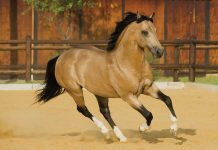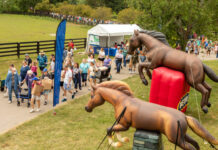
Bareback riding can be lots of fun, and it can improve your riding skills, too. When you ride without a saddle, you have to rely on your seat, your legs and your balance more than usual. You learn to move with your pony. It’s easier to follow your pony’s movement when you don’t have a saddle separating you.
Here are some rules to follow when riding bareback:
|
Comfy Seat
If your pony has a wide back, he’ll probably be quite comfy to ride. If he’s got a big backbone, riding him may be uncomfortable, and you might need to use a bareback pad. Bareback pads are pretty inexpensive. They are like saddle pads with a girth.
Mounting
Unless you are a vaulting champ, you may need a leg up to mount your pony when riding bareback. Or use a mounting block. Try to mount quickly and lightly.
Faster Speeds
Make sure that you’re totally in control of your pony before you ask him to trot or canter. Bareback riding might seem easy when you’re walking, but trotting is a lot bumpier and cantering seems a lot speedier without a saddle. Before you ask for the trot, press your seat into your pony’s back and try to relax. Let your legs hang down long. Your thighs and calves should touch your pony’s sides. Don’t grip with your knees when your pony speeds up.

If you bump around too much, lean forward a bit and grab hold of some mane.
When you get used to the faster gait, sit up and tall and try to absorb your pony’s movement with your body. Try not to yank on your pony’s mouth with the reins. Keep your hands as still as you can.
Once you’ve mastered sitting trot, try posting. Stay on the correct diagonal as you trot around the ring. The same goes for cantering. Make sure you’re on the correct lead.
Ask for the canter just like you would if you were riding in a saddle. Keep your inside leg near the imaginary girth, and nudge your pony with your outside leg behind the imaginary girth.
Stick to a slow, collected canter so there’s no chance of losing your balance.
Exercises
When you first get on your pony bareback, walk slowly around the ring a few times. You may not feel very secure at first—riding bareback can seem kind of wobbly—so do some exercises to help you get more balanced on his back. Do some arm swings, toe touches and leg lifts. If someone will hold your pony, you can try the around the world exercise on him.
Jumping Bareback
Jumping bareback can be hard on your pony, especially if you get left behind and bounce around on his back. Use a neckstrap or grab hold of some mane to make sure you jump with your pony, not after him! Stick to small fences, and only jump if you are in total control of your pony.

I’m Falling Off!
If you find yourself slipping off your pony at some point and can’t shift yourself up on to his back again, you might have to do an emergency dismount so you don’t eat dirt. Press your hands on his neck and push up, swing your leg over and leap away from your pony. Land facing forwards, with both feet on the ground and bend at the knees. If your pony stops or slows down, grab hold of the reins. If he runs off let go. Better to break the reins than your arm!
Thanks to Jock Gurnee and the gang at Bittergreen Farm in Mt. Sterling, KY for their help with this feature!
This article originally appeared in Young Rider magazine. Click here to subscribe!





